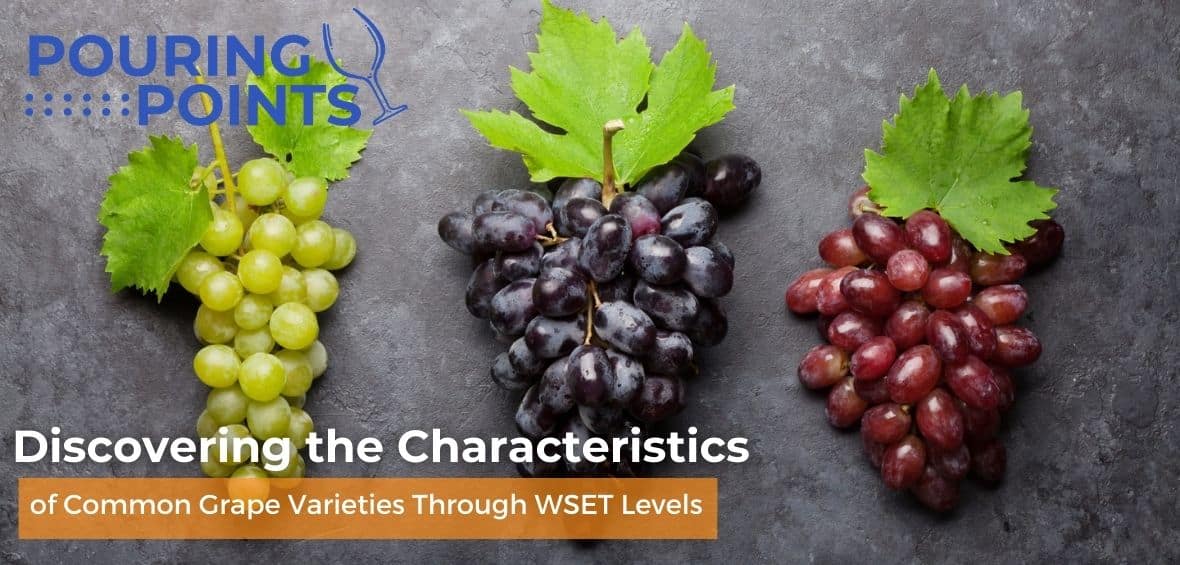The Wine & Spirit Education Trust (WSET) program offers an enlightening journey into the world of wine, providing a detailed study of the most common grape varieties: Cabernet Sauvignon, Merlot, Syrah, Pinot Noir, Chardonnay, Sauvignon Blanc, Pinot Grigio, and Riesling. As students progress through the WSET levels, their understanding deepens, exploring how these varieties are cultivated and transformed into wine across the world.
Level 1: Introduction to Varietal Characteristics
In Level 1, students begin their exploration of the eight grape varieties by understanding their fundamental characteristics. For instance, they learn about the typical climates for Cabernet Sauvignon and Merlot and their basic flavor profiles. This level introduces the foundational aspects of each grape, such as the light, crisp nature of Pinot Grigio and the floral notes of Riesling.
The study at this level is about grasping the essential features of each variety. Students become familiar with the basic aromas and palate profiles of Syrah and Pinot Noir, laying the groundwork for a more comprehensive understanding in subsequent levels.
Level 2: Deepening Regional Knowledge
In Level 2, the exploration of each grape variety becomes more nuanced, building upon the foundational knowledge established in Level 1. For example, while Level 1 introduces the basic characteristics of Chardonnay, such as its primary flavors and the climates it thrives in, Level 2 delves into how Chardonnay’s expression varies significantly between regions like Burgundy and California. This comparison emphasizes the grape’s versatility and the influence of terroir on its stylistic variations.
Similarly, the study of Cabernet Sauvignon at Level 2 expands upon Level 1’s introduction to the grape’s fundamental traits. Level 1 might cover the basic tannin structure and flavor profile of Cabernet Sauvignon, while Level 2 explores how these characteristics manifest differently in wines from Bordeaux compared to those from Napa Valley, illustrating the impact of regional winemaking practices and climatic conditions.
The concept of “style statements” in Level 2 also enhances the understanding of other varieties like Sauvignon Blanc and Merlot. If Level 1’s focus for Sauvignon Blanc was on its general aromatic profile, Level 2 examines how this profile changes from the grassy, crisp wines of New Zealand to the more mineral-driven versions from France’s Loire Valley. For Merlot, Level 2 builds on the introductory knowledge of its soft tannins and fruity flavors by showcasing how these attributes vary in wines from different regions.
This comparative approach in Level 2 helps students appreciate the complexity of wine and the multifaceted nature of each grape variety, illustrating how a deeper understanding of region and winemaking techniques can significantly alter the perception and enjoyment of wine.
Level 3: Expanding Regional Understanding and Quality Analysis
At Level 3, the WSET program enhances students’ understanding of each grape variety by providing a more comprehensive view of the famous wine regions around the world. This level examines how different regions influence the styles and quality of wines made from common varieties like Cabernet Sauvignon, Merlot, Syrah, Pinot Noir, Chardonnay, Sauvignon Blanc, Pinot Grigio, and Riesling. Students delve into the finer details of vineyard and winery practices, exploring how these elements contribute to creating wines of varying quality levels.
In this stage of learning, the focus shifts from just understanding the regional styles, as in Level 2, to analyzing the broader spectrum of wine quality across various regions. Students study the intricate details of winemaking choices for varieties like Chardonnay, understanding how different fermentation and aging methods can transform the grape’s expression in regions from Burgundy to California. The curriculum also involves an in-depth exploration of viticultural practices that affect wine quality, offering a more nuanced perspective on grape-growing conditions and their impact on wines like Pinot Noir and Riesling.
This level goes beyond regional comparisons to a more sophisticated analysis of global wine production. Students learn to appreciate the full potential and versatility of each variety, considering the complex interplay of terroir, climate, and human intervention. By the end of Level 3, students are equipped with a comprehensive understanding of how these common grape varieties are expressed differently in renowned wine regions around the world, fostering a deeper appreciation of their unique characteristics and quality levels.
Level 4: Advanced Comparative Analysis and Global Perspective
Level 4 of the WSET program demands a highly nuanced understanding of each grape variety, extending far beyond the regional focus of the previous levels. This stage involves advanced comparative tastings and in-depth research, allowing students to analyze the complexities and subtle variations of grapes like Cabernet Sauvignon and Merlot as they are expressed in a broad range of global regions. For example, students might compare a Cabernet Sauvignon from Bordeaux’s left bank to one from Napa Valley, noting the differences in terroir and winemaking techniques.
For each of the eight varieties, including Chardonnay, Sauvignon Blanc, Pinot Grigio, Riesling, Syrah, and Pinot Noir, Level 4 provides a platform for students to conduct thorough examinations into their distinct expressions across different wine-producing areas of the world. This level not only involves tasting but also includes an exploration of the historical, cultural, business and technical aspects that influence these varieties globally. Students engage in a detailed analysis of how regional differences, vineyard practices, and winemaking choices across the world contribute to the unique character of each variety.
Through this comprehensive approach, Level 4 equips students with the ability to discern the subtle nuances and quality levels of wines made from these common grape varieties, culminating in a thorough and sophisticated understanding of their global expressions.
Building Knowledge Across Levels
Throughout the WSET levels, knowledge of these common grape varieties is built progressively. Starting with basic characteristics and gradually moving to more complex regional and quality comparisons, students develop a nuanced understanding of each variety. Tastings become more specific, focusing on quality and regional differences, allowing for a sophisticated appreciation of these common yet diverse wines.
Studying the most common grape varieties through the WSET levels is an enriching process that deepens with each level. From understanding basic varietal characteristics to exploring intricate regional differences and winemaking techniques, students gain comprehensive knowledge, preparing them to appreciate and discuss these wines confidently and knowledgeably.














